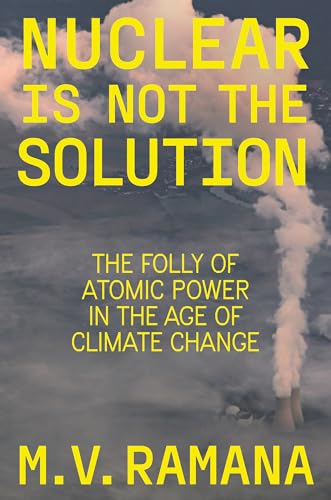Against the Current No. 236, May/June 2025
-
Lessons of Abductions and Terror
— The Editors -
Vets Mobilize vs. DOGE
— Steve Early & Suzanne Gordon -
Upholding Reproductive Rights in Ohio & Beyond
— Marlaina A. Leppert-Miller -
The Humanities After Gaza
— Cynthia G. Franklin -
On Social Movement Media: Learning from Krupskaya & Lenin
— Promise Li -
The Rule, Not the Exception: Sexual Assault on Campus
— M. Colleen McDaniel & Andrew Wright -
Diktats, DOGEs, Dissent & Democrats in Disarray in the Era of Trump
— Kim Moody -
A Setback for Auto Workers' Solidarity
— Dianne Feeley - Columbia Jewish Students for Mahmoud Khalil
-
Plague-Pusher Politics
— Sam Friedman - Guatemala Human Rights Update
- A Remembrance
-
Fredric Jameson's Innovative Marxism
— Michael Principe - Reviews
-
The New Nuke Revival
— Cliff Conner -
Power in the Darkness
— Owólabi Aboyade -
Racial Capitalism Dissected
— James Kilgore -
An Important Critique of Zionism
— Samuel Farber -
What's Possible for the Left?
— Martin Oppenheimer -
Behind the Immigration Crisis
— Folko Mueller
Cliff Conner
Nuclear is Not the Solution:
The Folly of Atomic Power in the Age of Climate Change
By M.V. Ramana
Verso, 2024, 272 pages. $29.95 hardcover.

LIKE THE PROVERBIAL bad penny, the threat of nuclear power keeps popping up, over and over again. No matter how many times the population of the Earth rejects it, every generation seems to be confronted by a fresh “renaissance” of this abominable idea that just won’t die.
From the perspective of the general public — our perspective — it’s not a glorious renaissance but a recurring zombie invasion.
When book browsers come across M.V. Ramana’s title Nuclear Is Not the Solution, some may wonder: “The solution to what?” But anyone who has followed the many-decades-long controversy over the generation of nuclear power for civilian purposes will quickly know the answer: “climate change,” or more to the point, “global heating.”
Unlike the false debate between climate scientists and climate-change deniers, the renewed dispute over nuclear power derives from a genuine problem that cannot be ignored — the fossil-fuel-driven climate crisis.
The proposal of nuclear power as the antidote to an existential danger is serious and worthy of thoughtful consideration: Is nuclear energy THE ANSWER to saving the Earth from ecocide by fossil fuels?
Advocates of nuclear power are trying to resurrect its moldy carcass once again by repackaging it as the only way to combat the existential threat of climate change. They aim to mobilize the youthful energy of environmental activists whose fear of global warming outweighs concerns about the dangers of nuclear power.
By doing so, they hope to create a groundswell of public opinion that will open the way to a new generation of nuclear reactors.
The SMR “Solution”
The industry is also offering a new technological gimmick: SMRs, or “Small Modular Reactors.” Unfortunately, some young environmental activists have been persuaded by this propaganda and are once again breathing new life into the nuclear zombie. Nuclear power, they believe, is now “cool.”
The purpose of physicist M.V. Ramana’s new book is to demonstrate exactly how uncool it really is.(1)
Those of us who have lived through a few “nuclear renaissances” may be tempted to think that Ramana can only be rehashing the same-old-same-old arguments we’ve heard before. We would be remiss to do so.
The case Ramana presents is as fresh and valuable as ever, because he has updated and extended the evidence and analyses of the past to fit the needs of the present moment. Anyone who encounters eager-beaver pro-nuke activists can enlighten them with the wisdom Professor Ramana has distilled into this relatively concise volume.
Historical Context of the Controversy
Nuclear energy made its first dramatic appearance on the stage of history with the Trinity atomic bomb test in July 1945. Less than a month later it was used to obliterate two Japanese cities and hundreds of thousands of their inhabitants, and it has ever since been a fearsome sword of Damocles hanging over the heads of all humanity.
President Eisenhower’s proposal of an international “Atoms for Peace” program in late 1953, however, initiated the prospect of a civilian use of atomic energy that would be enormously beneficial to humankind rather than an existential threat.
While many people did not question the promise of nuclear power as a potential source of unlimited, clean, safe, inexpensive energy, many others were skeptical and warned that its safety was unproven and could not be merely assumed.
A public debate ensued, resulting in a grassroots antinuclear movement of massive proportions that succeeded in imposing sharp limitations on the size and spread of the nuclear power industry.(2)
The movement’s warnings were vindicated by a number of nuclear disasters and near-disasters, most notably the meltdown and massive escape of deadly radiation at a nuclear plant in Chernobyl, Ukraine.
Meanwhile, the privatized, heavily subsidized nuclear energy industry had built and was operating dozens of electricity-generating plants driven by nuclear reactors throughout the United States and in a number of other countries.
In the wake of a frightening meltdown at Three Mile Island in Pennsylvania (1979) and the subsequent catastrophe at Chernobyl (1986), the nuclear industry encountered massive public pushback and went into eclipse. Although never shutting down entirely, its energy-producing capacity was significantly curtailed.
Investors who had put millions of their dollars into nuclear energy were loathe to simply write off those highly profitable investments, and kept up a massive public relations and lobbying effort to convince public opinion of the safety and “cleanliness” of their product. The opposition to nuclear energy, over time, waned and the nuclear industry began to recover its lost ground.
Its comeback, however, was cut short by another massive accidental escape of radiation in 2011 at a nuclear power plant in Fukushima, Japan, and once again the international nuclear energy industry went into a tailspin. Germany closed eight of its oldest reactors and promised to phase out all of them; its last three nuclear power plants were shut down in April 2023.(3) Switzerland pledged to do the same by 2034.
In the United States, the industry had already been in decline for economic reasons; the Fukushima disaster accelerated that trend. It had remained in the doldrums until recently, when the bad penny popped up again in the form of a major PR and lobbying campaign promoting the innovative SMR technology.
The antinuclear movement has begun to shake off its complacency and push back, declaring, as Professor Ramana convincingly explains, that SMRs are nothing more than the same old nuclear technology operating on a tiny scale. They can be expected to produce more radioactive waste per megawatt hour than large reactors.
The industry’s claim that SMRs will be more economically viable is especially ludicrous, because their only innovation deprives them of economies of scale.
Is Nuclear Power “Clean Energy”?
The pro-industry propaganda utilizes a familiar debater’s ploy by importing the desired conclusion into the terms of the debate itself. They use the term “clean energy” as a synonym for “nuclear energy,” but if nuclear energy is unambiguously “clean,” then the debate is over and nuclear energy is indeed the solution to the climate crisis.
The cleanliness of nuclear energy, however, refers only to the fact that, unlike fossil fuels, it does not add greenhouse gases such as carbon dioxide or methane to the Earth’s atmosphere. That is a powerful argument in its favor, but unfortunately nuclear reactors introduce another highly undesirable pollutant into the environment: ionizing radiation that poses a severe threat to human and nonhuman health.
The antinuclear movement has long insisted that the radiation danger makes nuclear power the dirtiest of all energy sources. Ionizing radiation enters the food chain, exposing organisms that eat the food to increased risks of cancers and other diseases, as well as to harmful genetic mutations that are passed on from generation to generation forever.
The Nuclear Waste Crisis
The radiation danger is twofold: not only from the possibility of catastrophic releases into the atmosphere, but also from the routine day-to-day operations of nuclear plants producing nuclear waste that irradiates the soil and groundwater.(4) As Ramana explains:
“Nuclear advocates reject concerns about radioactive waste. Bill Gates is a good example. In a February 2023 interview with CNBC, he dismissed waste as ‘not a huge problem,’ because it can be put into deep boreholes underground ‘where it stays geologically for hundreds of millions of years’… But the confidence expressed by the founder of Microsoft is misplaced. We don’t really know, and we cannot know, if the waste will really stay put for hundreds of millions of years.” (50)
Despite the false assurances of the nuclear industry, the radioactive waste problem has long been out of control In the United States. In 1982, more than four decades ago, the Congressional Quarterly reported that a solution was then already almost four decades overdue:
“Although there had long been broad general agreement on the need for legislation to establish a comprehensive national policy for the disposal of highly radioactive nuclear waste, no such legislation had been enacted during the nearly 40 years that nuclear waste had been generated in the United States.”(5)
In 2002 the U.S. Congress finally approved a plan to build a national nuclear waste repository at Yucca Mountain, Nevada. The state of Nevada, however, objected to being the national nuclear dumping ground, so the project went into limbo. As of December 2023, the Environmental Protection Agency reports, “The future of the Yucca Mountain repository is uncertain.”(6)
Ramana’s assessment is more explicit: “That project is essentially dead.” (98)
Meanwhile, more than 80,000 tons of spent fuel will presumably continue to be stored in pools or dry steel-and-concrete casks at a hundred or so separate sites across the country — the ones that had been running out of space in 1982, and that had never been designed for long-term storage in the first place.
Civilian and Military Nuclear Energy
Another widespread public fear is proliferation of nuclear weapons. Pro-nuke advocates have in the past downplayed that highly rational fear by minimizing the intimate links connecting the commercial nuclear industry with the military-industrial complex.

Physicist Ramana, however, reminds us of “the reality that nuclear energy cannot be separated from nuclear weapons.” (195)
Making a nuclear weapon requires weapons-grade fissionable material, either enriched uranium or plutonium. The same technology that can enrich uranium can enrich it enough to make weapons, and all nuclear reactors produce plutonium. “What a country does with the plutonium is its decision,” Ramana comments. (172)
He also points out an unexpected turn in the discourse on this subject:
“After decades of trying to maintain that there was a clear separation between civilian and military nuclear technologies, supporters of nuclear power have been switching the argument in the last couple of decades, especially whenever the nuclear industry is in economic distress. Then nuclear power advocates highlight the connection and make the case that a healthy nuclear power industry is essential to the production of nuclear materials for war….
“Perhaps the greatest irony is the argument’s use in the one country that has suffered from the use of nuclear weapons in war. In 2011, as the Japanese nuclear industry was reeling from the catastrophic Fukushima accident, an official from the Liberal Democratic Party, which has dominated Japanese politics for decades, argued that Japan’s capabilities in nuclear power and ‘leading-edge rocket technology’ make it ‘possible to create nuclear weapons in the relatively short time of several months to a year.’” (188)
Artificiality of Nuclear Industry Economics
Consider this apparent paradox. On the one hand, “The nuclear industry has had decades to try and establish itself as an economical source of energy, and it has failed.” (95) But then “why do corporations get involved in this enterprise at all?”
The answer is that “they do so only when the public can be made to bear a large fraction of the high costs of building nuclear plants and operating them, either in the form of higher power bills or in the form of taxes.” (97–98)
That still doesn’t explain how investors can expect taxes to make their investments profitable. Why should the government expend money taken in from taxation to subsidize a chronically failing industry?
Ramana explains: “Understanding the specific connections between nuclear weapons and nuclear energy is essential to comprehending why governments continue to support nuclear power, despite the myriad problems associated with the technology.” (195)
The immense governmental subsidies for the U.S. nuclear power industry continue to be driven by the military’s desire to disguise its secretive nuclear operations as “atoms for peace” as much as possible.
The commercial nuclear industry is motivated, like all of corporate America, by a quest for profits, but its profitability has from the beginning been entirely dependent upon massive government subsidies. This particular example of governmental largesse is rarely acknowledged in the public discourse for the same reason that military spending in general is deemed sacrosanct.
Factoring in those subsidies renders irrelevant the false claim that the new SMR technology can make the nuclear industry economically viable. (This is a key consideration in a society in which an industry must be profitable to exist. A society that prioritizes human needs over corporate profits would pay whatever costs are necessary to avoid a terminal planetary climate catastrophe.)
The civilian nuclear industry has never been financially self-sustaining and is highly unlikely to ever be. For one thing, if commercial nuclear power plants had to pay the costs of their nuclear waste storage themselves, their profitability would be an impossible dream. For another, if they had to finance their own insurance risk, they simply could not survive.
Without endlessly increasing government subsidies and legislation limiting its liability for catastrophic accidents, the industry would be unable to function.(7)
No Technological Fix for Climate Crisis
The most general flaw in the nuclear renaissance propaganda is that it reduces a political and economic problem to an engineering problem. A solution to the global climate crisis will certainly include technology inputs, but no “technological fix” can solve the problem in the absence of fundamental societal change.
The solution requires getting rid of fossil fuels entirely, and that will not happen simply by making a technological alternative available. The oil, coal, and gas industries are trillion-dollar industries. The investors who own them will not simply walk away from trillions of dollars of their wealth.
As Professor Ramana makes clear in his book’s conclusion, the global climate crisis is systemic, by which he means it is endemic in our current social and economic systems.
“Absent fundamental changes, the impacts of the extractive processes associated with any form of electricity generation will only continue to accelerate. Capitalism is based on continuous economic growth. For this continuous economic growth to take place, capitalism needs energy and materials to feed ever-expanding production. But material and energy use cannot keep growing continuously on a finite planet.”(242)
The solution to the climate crisis — an all-out global Manhattan Project–scale effort — is incompatible with capitalism. It would require the advent of governments that prioritize solving it above the profit interests of the corporate entities that now control them.
Notes
- M.V. Ramana is Professor and Simons Chair in Disarmament, Global and Human Security at the School of Public Policy and Global Affairs at the University of British Columbia in Vancouver, Canada, and the author of The Power of Promise: Examining Nuclear Energy in India. Ramana is a member of the International Panel on Fissile Materials, the Canadian Pugwash Group, the International Nuclear Risk Assessment Group, and the team that produces the annual World Nuclear Industry Status Report. He is the recipient of a Guggenheim Fellowship and a Leo Szilard Award from the American Physical Society.
back to text - The largest antinuclear demonstration in U.S. history took place on June 12, 1982 in New York City. See: https://www.armscontrol.org/blog/2018-06-10/fight-continues-reflections-june-12-1982-rally-nuclear-disarmament
back to text - Not surprisingly, nuclear power investors are already pushing for a “nuclear renaissance” in Germany. See: “Restarting Germany’s Reactors: Feasibility and Schedules.” https://www.radiantenergygroup.com/reports/restarting-germanys-reactors-feasibility-and-schedule
back to text - In addition to the radioactive waste produced by nuclear reactors is the waste produced by uranium mining. See EPA.gov, Radioactive Waste From Uranium Mining and Milling: “In the past, the waste rock produced by underground and open pit mining was piled up outside the mine. This practice has caused problems, including on Navajo lands where more than half of the small, abandoned uranium mines from the middle of the 20th century and their wastes remain. Wind can blow radioactive dust from the wastes into populated areas and the wastes can contaminate surface water used for drinking. Some sites also have considerable groundwater contamination.”
back to text - Congressional Quarterly, “Comprehensive Nuclear Waste Plan Enacted,” 1982.
back to text - Environmental Protection Agency, “Frequent Questions: Radioactive Waste,” epa.gov, last updated December 8, 2023: https://www.epa.gov/radiation/frequent-questions-radioactive-waste#yucca-mountain
back to text - See: Taxpayers for Common Sense, “Understanding Nuclear Subsidies — In Brief,” March 21, 2021; and US Nuclear Regulatory Commission, “Backgrounder on Nuclear Insurance and Disaster Relief,” last updated April 11, 2022.
back to text
May-June 2025, ATC 236

